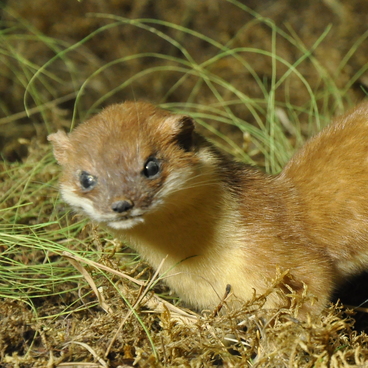The Russian desman belongs to the family of moles and desmans, the insectivorous. Its Latin name is Desmana moschata. It is a small animal with an 18-22 cm-long body and a tail of the same length; it weighs up to 520 grams. The desman has 44 teeth. Its eyes are the size of a pinhead. Desmans are nearly blind, but have a well developed sense of smell and touch.
The Russian desman belongs to the family of moles and desmans, the insectivorous. Its Latin name is Desmana moschata. It is a small animal with an 18-22 cm-long body and a tail of the same length; it weighs up to 520 grams. The desman has 44 teeth. Its eyes are the size of a pinhead.
Desmans are nearly blind, but have a well developed sense of smell and touch. The long-tailed animal the size of a large rat is easily recognizable by its long flexible snout. Its upperparts are dark brown, while underpants are light with a strong shine.
Its extremities are rather short and feature five fingers; its hind feet are larger and wider than the forefeet. Its claws are well developed. The huge feet are webbed to the tips of the digits and are fringed with stiff hair which increases its swimming surface.
The desman’s fur is thick, velvety and very strong. Its hair structure differs from that of other animals: its hairs become wider closer to the top and get narrow сloser to the root. The fur holds air so well that a parasite lives there - the ‘desman beetle’, which is incapable to breath in the water.
The desman leads a semiaquatic lifestyle. Most often it lives in floodplain reservoirs with areas of low, but dry steep banks and aquatic vegetation. The animals live in dens most of the year, each of which has one exit, opening underwater. The main part of the tunnel, located above the water level, goes almost horizontally for 2.5-3 meters and features 2 or 3 extensions (chambers or rings).
During the flood period, the chambers are flooded, and the animals leave them to hide in semi-flooded trees, in piles of sediment or in shallow temporary dens, dug on the banks.
The desman is active all year round, mostly at dusk. It feeds on shellfish, water insects, leeches, frogs, and less frequently on plant rootstalks. The silt in the animals’ dens is soaked in musk. It is a special substance that attracts insects, mollusks and worms.
The desman was a commercial species in the past, but it is a rare animal nowadays. Many animals die in fishing nets and muskrat traps. The desman is listed in the Red Book of Russia and the Kurgan region.

